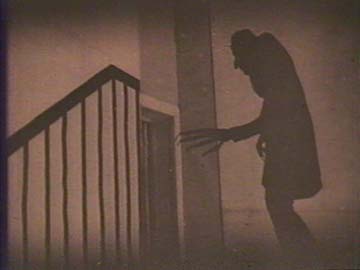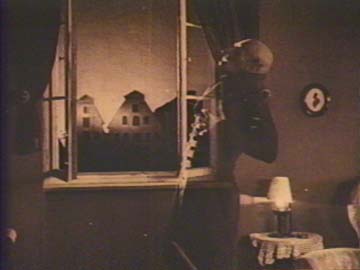

In Nosferatu (F. W. Murnau, 1922), among the first horror films ever made, the vampire Count Orlok (Max Schreck) is a creature of light and shadows, born of cinematic magic. He floats straight up from his dark coffin, materializes in gothic arches, passes invisibly through stone walls, and eventually pursues the heroine into a room where she waits alone, terrified, ready to sacrifice herself to save her husband. The most chilling sequence in this still-scary movie is Orlok's ascent up the stairs, shown largely through his hideous shadow, great claw-like fingers extended.
In this movie all my themes come together: a repulsive figure in a beautiful film, the victimization of a woman by a monstrous man, his evil vs. her purity and moral strength--a patriarchal picture that paints her as worthy because she will die for the man she loves. Her heroism does succeed in the sense that she detains the vampire until, in this movie, he is destroyed by a route Bram Stoker did not envisage--the light that enters her room at dawn. Sunlight magically banishes him into a screen-magic puff of disappearing smoke. Similar tricks of cinematic magic abound in the films I have discussed.

I have argued in this book that horror films may present subtle, nuanced, and interesting symbolic visions of evil--that they need not be "stupid" or "juvenile," to quote again the pejorative terms director David Cronenberg also rejects. Horror films have appeal because they continue a lengthy tradition of art-making as they address human fears and limitations, forcing confrontations with monsters who overturn the natural order--of life and death, natural/supernatural, or human/non-human. They depict vivid threats to our values, concepts, and our very bodily and mental integrity. As a cognitivist, I hold that such films, like other cultural artifacts, engage many of our intertwined human abilities. Horror films may aim at producing gut-level reactions such as fear, revulsion, anxiety, or disgust, but they also stimulate more complex emotional and intellectual responses. They provide visions of a world where action may or may not have meaning, where a monster may or may not be sympathetic, where evil people may or may not win out in the end.Nosferatu provided a moral resolution at the cost of the heroine's life, and so also did Aliens3 many years later. But sometimes horror subverts standard gender ideologies; the sources of evil are unstable and shifting and often lie hidden beneath the surface. In Frankenstein and all its many successors, men (or women) who meddle with nature must pay the price. Horror films like Frenzy or Repulsion depict male violence against women so as to condemn it and make plain its monstrosity. In "Women and Bugs" movies, heroines help to restore order and justice, often by bringing intellect, strength, and intuition, in addition to emotions like maternal caring, into the picture. Vampire movies may loosen strict gender role expectations by exhibiting attractive figures of polymorphous perversity. In uncanny films like The Shining or Eraserhead men become evil destructive fathers as signs of a universe run amok. Even graphic horror movies with super-humanly violent male monsters like the Texas Chainsaw family can highlight female heroes who help set the moral order straight again in the end--and this time not by sacrificing themselves.
And what of evil? Evil was obvious in Murnau's Nosferatu. It dwelt in the vampire who brought plague wherever he went. It was simply death, and not conversion or seduction. By contrast, the vampires in Anne Rice's stories are seducers seeking partners in a shared life that "transvalues values." Pinhead's evil is instructively different: he offers people their due rewards, pain justly deserved for transgressive behavior. Pinhead sees himself as the Anti-Christ; he is a Lucifer with the role of punisher rather than seducer into sin. He is always defeated but "the box" that calls him survives, and so will human evil. This may seem simplistic; many horror films offer subtler but equally grim verdicts about human nature and the predominance of evil. We have seen movies with dire messages like The Shining, Dead Ringers, Henry: Portrait of a Serial Killer, and Repulsion, as well as more seductively cynical ones like The Hunger and The Silence of the Lambs. Still others offer up charms against evil--perhaps "female" values as in the Frankenstein tradition, the romantic love and repentance showcased in Bram Stoker's Dracula, or even "Art" itself, as at the end of Eraserhead.
Most of all, horror movies are about the very picturing of evil. Monsters in horror are, like Count Orlok, made of light and shadow, creatures born of film. There are recurring allusions in horror films to the nature of our very fascination with horror--allusions to the processes of cinematic depiction, pleasures of spectacle, and to traditions of symbolic representations of evil and monsters. These show up in the formulas repeated in certain genres (the laboratory birth scenes of Frankenstein, the scenes of "the book" or "the bite" in Dracula movies). Francis Ford Coppola's Dracula is someone we, like Mina, recognize in the Cinematograph as a character we already know and love. Movies in the slasher tradition foreground the watching and filming of the atrocities they picture, inviting us into or excluding us from their villainous characters' perspectives. By "picturing" I mean the whole of cinematic art: special effects, sound, and music, as well as images, plot, and acting. We saw in such different movies as The Shining, Eraserhead, Repulsion, and Scanners that uncanny watchers are central: present not just in the unsettling scenes we view, but also in what we hear--eerie heartbeats, echoes, ticks, clangs, and hisses. Orlok's evil has been updated and revamped in Pinhead, one of our newest movie monsters. Hellraiser gives us a new-yet-old version of the same cinematic monster magic, the creation of an evil creature who lives only on film and who dies in the light (Picture 9.2). Pinhead materializes from and dematerializes back into the light, just like Orlok. Pinhead and monsters like him will come to anyone operating the magic camera-like box, with its gleams of light and tinkling sounds. The allure of horror is that such monsters come out of their box to entertain, perplex, disturb, and provoke us, as they confront us with a multitude of visions of evil.
forthcoming from Westview Press, 1999